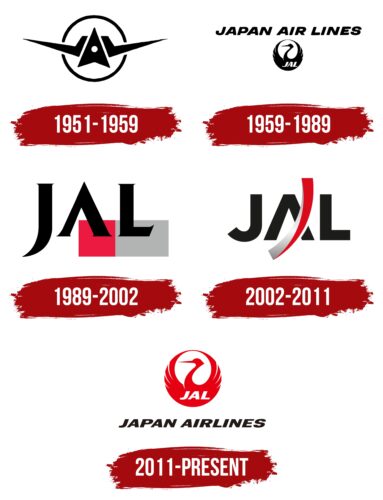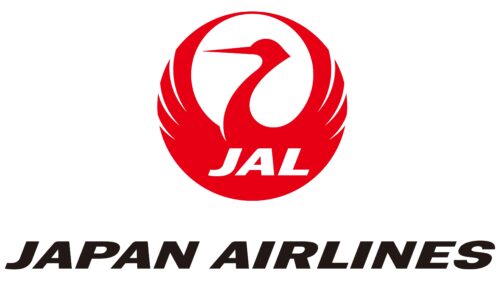The logo of Japan Airlines is regarded as a symbol of reliability, prosperity, longevity, and peace because it features the image of a crane, Japan’s most beloved bird. This bird is a national symbol, making the airline’s emblem unique and deeply rooted in the culture of its home country.
Japan Airlines: Brand overview
Japan Airlines (JAL), established as Japan’s national carrier on October 1, 1951, embarked on its journey.
The airline commenced domestic flights on October 25, 1953, with a route from Tokyo to Osaka.
The brand ventured into international skies on February 2, 1954, launching its first international flight from Tokyo to San Francisco.
Throughout the 1960s, the aviation firm expanded its global network and modernized its fleet by acquiring its first jet aircraft.
In 1970, the company added the Boeing 747 to its fleet, becoming an early operator of this aircraft type.
A partial privatization process began in 1983, culminating in 1987, with the brand becoming a fully private entity.
Tragedy struck on August 12, 1985, with the crash of Flight 123, marking the deadliest single-aircraft accident in history.
By 1987, the airline had transitioned to a fully privatized company.
In 2001, the company announced a merger with Japan Air System (JAS), which concluded on April 1, 2004, forming the Japan Airlines Corporation.
The brand joined Oneworld’s global aviation alliance in 2007, becoming a full member.
On January 19, 2010, the airline filed for bankruptcy protection and initiated an extensive restructuring process.
The air operator emerged from bankruptcy in 2011, having successfully reorganized.
The company returned to the Tokyo Stock Exchange on September 19, 2012, with its shares resuming trading.
In 2013, the brand welcomed its first Boeing 787 Dreamliner into its fleet.
In 2017, the airline invested in Boom Technology, a company that developed a supersonic passenger aircraft.
The launch of ZIPAIR Tokyo, the budget airline, took place in 2018.
By 2020, the air operator had adapted its operations to meet changing market conditions, focusing on domestic flights and cargo services.
Meaning and History
What is Japan Airlines?
This is Japan’s flagship carrier and one of the largest airlines in Asia, based in Tokyo. The company offers an extensive global route network, covering numerous destinations within Japan, as well as in Asia, Europe, North America, Australia, and Guam. It operates a modern and diverse fleet of wide and narrow-body aircraft, including Boeing 787 Dreamliner, Boeing 777, Airbus A350, and Boeing 737, ensuring exceptional comfort, service, and efficiency.
1951 – 1959
The aviation theme is deeply embedded in the Japan Airlines logo. It features an airplane that occupies the entire space of the emblem. The design is created in a cubist style, dominated by geometric shapes. These shapes form the necessary silhouette, using triangles, circles, and trapezoids combined uniquely. Some of them are joined into large checkmarks that act as wings. The central position is given to a massive triangle with a cutout at the bottom and a large white dot in the middle. These elements together represent the rear view of an airplane.
A narrow ring surrounds the airplane, intersected by the long wings’ sharp tips. The circle symbolizes the sun, toward which the airplane is flying straight, determined, and confidently. Despite the sharp angles, hard edges, and standard geometric shapes, the design conveys positive energy because the sun symbolizes warmth, goodness, light, comfort, mental balance, and tranquility.
The emblem is executed in monochrome, with only black and white forming the core of the color scheme. This palette is not particularly optimistic—it reflects a tragic view of the world rather than busibusinesslike the same time, it emphasizes the minimalist style in which the airline’s emblem is presented. It conveys a sense of contrast between strength and lightness.
1959 – 1989
The logo of this period represents a harmonious blend of high technology and Japanese traditions. It embodies the infusion of ancient culture into modern life. The emblem conveys respect, flexibility, quality, and reliability of a company guided by global perspectives but not forgetting the past. The crane captures this essence, a national symbol of Japan.
The crane has deeply rooted itself in local traditions and expresses significant values: longevity, determination, loyalty, happiness, and hope for the future. In this context, it symbolizes movement and migration, promising travelers an easy and fast journey, which aligns perfectly with the mission of an airline. It foretells peace and tranquility in flight, which the company strives to provide for its customers. The crane signifies:
- A deep connection with Japan’s cultural heritage;
- The brand’s association with a specific country;
- Adherence to national traditions;
- Comprehensive support for passengers;
- A heartfelt attitude towards travelers;
- A desire to please everyone who uses the carrier’s services.
The bird is depicted with wings raised upwards, joined above its head. It seems to encompass the space around it, aiming to protect everyone and shield them from troubles. Against a black background, the inscription “JAL” is painted in white. This classic contrast creates a businesslike atmosphere and ensures good readability.
The abbreviation is typed in a sans-serif font in uppercase. It conveys the shortened form of “Japan Air Lines,” placed above in an italic font. The slant adds energy and dynamism to the logo, reflecting the nature of the Japanese airline’s business. The bold black glyphs emphasize reliability and stability, while the white ones signify honesty and openness.
1989 – 2002
Despite the absence of the crane in the new Japan Airlines logo, the bird is still depicted allegorically. Its image is well conveyed through several key details:
- The “J” looks like a wing.
- The “A” is shaped like a beak.
- The “L” resembles a flying bird.
The abbreviation is abstract, with fragmented elements of the crane’s body that are letters. This combination reflects the direct connection between aviation and the national symbol of Japan: high technology, reliability, freedom, and flight. It is a harmonious blend of the natural and the man-made—what nature has created and what professionals have crafted.
The emblem has many other characteristics that make it unique and authentic. For example, the bold capital letters have tiny serifs. They are almost invisible but still present, reminiscent of the crane’s sharp beak and claws. Another distinctive feature is the rectangle painted in red and gray. The red is taken from Japan’s national flag, and the gray is the plumage of the crane. The elegant “J” looks like the graceful neck of a crane.
This way, the airline indicates its field of activity and respects Japanese culture, national heritage, and uniqueness while forecasting plans for the future. The emblem leaves a lasting impression on travelers, subtly encouraging them to enjoy a comfortable flight using the company’s services.
2002 – 2011
The updated Japan Airlines logo conveys a fresh concept for the Japanese brand. The emblem is essentially a modern version of the old one, retaining all the previous components but in a modernized style:
- The name (the abbreviation does not have serifs and does not resemble a crane).
- Geometric figure (a bracket is used instead of a rectangle).
- Two-tone color scheme (red and gray now have a gradient).
Upon closer inspection, several new features can be noted, such as the expanded symbolism of the elements. This is seen in the sideways-turned arch painted in two iconic colors. It takes the shape of a passenger seatback and the graceful neck of a crane, but it is a stylized crossbar of the letter “A.”
Another significant detail is the color. Red and gray (one of the shades of the Japanese crane’s plumage) now have a gradient, which greatly enriches them. Against the two-dimensionality of other elements, this color scheme looks vibrant and voluminous.
Although the uniqueness and character of the emblem have decreased, it now conveys another equally important mood—professionalism. Through the new identity, the airline demonstrates high responsibility, friendliness, accessibility, safety, and seriousness, perfectly confirming its corporate policy toward customer service.
2011 – today
The red circle holds a prominent role in Japanese mythology. This is evident when looking at the national flag of Japan, adorned with a large red circle. Japan Airlines adopted this circle and combined it with another symbol—the crane. There are several reasons for this:
- Japan is known as the Land of the Rising Sun.
- The circle represents the cycle of nature.
- The inner space symbolizes a well-protected area.
- The red circle signifies the sun, providing energy and vitality.
The presence of the circle in the emblem speaks to the airline’s global reach, extensive network, and importance on a planetary scale. Red is considered sacred in Japan. The next iconic image is the crane, found in most national legends. It symbolizes a bright future, peace, and prosperity. Its elegant figure makes the logo airy and light. The emblem includes the company’s name in two forms:
- Short form (the abbreviation on the bird’s chest with raised wings).
- Full form (black text below the symbol).
The lower text is set in bold black glyphs. They are smooth, grotesque, and wide, signaling the brand’s reliability and inspiring trust. A slight italic touch adds internal movement to the emblem, making it lively and dynamic. The white inscription on the crane is smooth and italic. It perfectly balances the black letters, infusing the logo with harmony.









